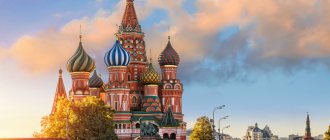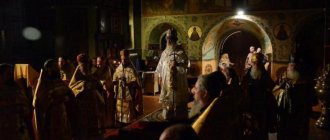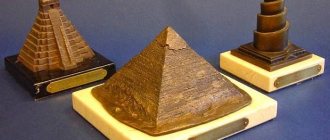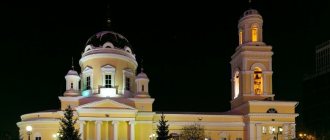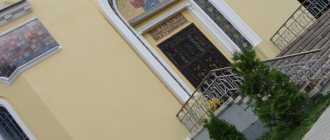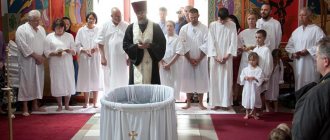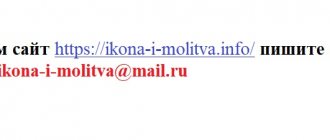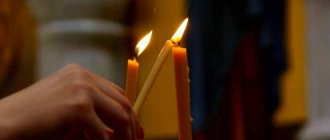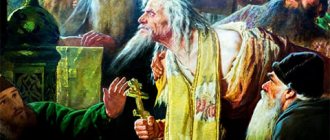Cathedral of the Assumption of the Mother of God and All Saints
Photo sourozh.org
Where:
67 Ennismore Gardens, London, SW7 1NH.
When:
The temple is open every Sunday, admission is free - from 12:00 to 18:00. For the Divine Liturgy (from 9:30 to 11:00) - admission by appointment.
Language of services:
Church Slavonic, English.
The Cathedral of the Assumption of the Mother of God is already a century and a half old: designed in the image and likeness of an Italian basilica, it was built in 1849. True, the cathedral was not always Orthodox: the Anglican Church once dominated this building. Now it belongs to the Sourozh diocese - it unites all the parishes of the Russian Orthodox Church in Great Britain and Ireland.
There is a school, kindergarten and library at the temple. English language courses are also held here.
Dormition Cathedral (London)
The Assumption Cathedral (English Dormition Cathedral) is the cathedral of the Sourozh diocese of the Russian Orthodox Church, the main center of the Orthodox community in London.
The full name of the attraction is the Cathedral of the Dormition of the Mother of God and All Saints, but among the British themselves the most popular is the simple one - Russian Orthodox Church. Content
| content: |
| history and description |
| photo gallery |
| schedule |
| admission ticket |
| useful links |
| address |
| on a map of London |
The appearance of the Assumption Cathedral in no way betrays its belonging to the familiar Orthodox tradition of golden domes and white walls. The building was built in the mid-19th century as an ordinary Anglican church. Architecturally, the cathedral completely copies the Romanesque Basilica of San Zeno Maggiore (Verona, Italy).
It is possible that the fate of the landmark, against the backdrop of a general decline in interest in religion, would have shared the fate of other church buildings turned into museums, hotels and even pubs, but the Russian Revolution of 1917 and the flow of emigration to England played a turning role. In the middle of the 20th century, the Orthodox community of London, which had grown exponentially (at the expense of emigrants and their children), began to think about the need for a large church. In 1956 , she leased the Anglican church, and 23 years later she was able to buy it. Metropolitan Anthony (in the world Andrei Bloom) became the rector of the cathedral. His name is associated with a growing interest in “Eastern Christianity” in the West and in Russian Orthodoxy in particular. Combining Western culture with the Orthodox faith and Russian tradition, Anthony managed over the years to increase the total number of followers in England to 250 thousand people, which made Orthodoxy the third largest religious movement in the country.
The interior decoration of the rented Anglican church was completely redone in the Orthodox style: large chandelier chandeliers, icons, both rescued from the USSR and painted by emigrants. The decoration of the walls is made in the “sgraffito” style, in which colored relief lines are created by scratching the top layer of plaster to the lower, colored one.
The iconostasis of the Assumption Cathedral was moved from the first Orthodox chapel in London, which existed from the beginning of the 18th century at the embassy of the Russian Empire until 1921. Many new icons were painted for him by the outstanding icon painter of the last century, Leonid Uspensky. Above the iconostasis is a fresco depicting the Crucified Christ, surrounded by symbols of the four evangelists. Other frescoes above the arches to the right and left of the central part of the cathedral depict biblical scenes.
Cathedral of the Nativity of the Blessed Virgin Mary and the Holy Royal Martyrs
Photo: wikiwand.com
Where:
57 Harvard Road, London, W4 4ED.
When:
The temple is open every Sunday, but services are held more often (the schedule is on the website). The nearest Divine Liturgy is August 11 at 9:00.
Language of services:
Church Slavonic, English.
In west London, not far from the Royal Botanic Gardens, there is another Russian parish. It belongs to the Russian Orthodox Church. The cathedral appeared quite recently: construction began in 1997, and the first service was held in 1999.
The church also has a school for children from 6 to 16 years old. Classes are held every Saturday, from September to July. Disciplines include Russian language, logic, and music.
Orthodox Life
The Cathedral of the Assumption of the Blessed Virgin Mary and the Holy Royal Martyrs is the cathedral of the British and Irish Diocese of the ROCOR, built in 1997-1999. Located in the London Borough of Chiswick, Hounslow.
The first Orthodox Russian parish in England was founded in London by Peter I in 1698 at the Russian embassy. From 1813 the temple was located at 32 Welbeck Street, in an annex located on the site of the stables, built immediately behind the spacious house. The Russian community was small, and the house chapel met their needs.
During World War I, the various Russian departments responsible for supplying military equipment to the Russian army expanded, and the Russian community began to grow. Towards the end of the war and the beginning of the revolution, a stream of refugees began to arrive. The defeat of the White Army increased this flow. The house church could no longer accommodate such a number of believers, and with the expiration of the lease on church land, it was necessary to find a new location. At the same time, the Ambassador Church was closed due to the anti-religious policies of the communist government.
The Anglican Church, with the assistance of the RHSD, gave the parish the opportunity to temporarily use a large church. Then, in 1923, the Church of England provided another, the Church of St. Philip the Apostle in central London. This temple, like all previous Russian churches in London, was consecrated in the name of the Dormition of the Blessed Virgin Mary.
In 1927, the Russian community in London was divided into “Evlogians” and “Karlovites” after the transfer of Metropolitan Eulogius (Georgievsky) and the parishes subordinate to him to the Patriarchate of Constantinople. An agreement was reached regarding the use of the church, whereby services would alternate each week. In 1928, the Russian Orthodox Church Abroad sent 38-year-old Archimandrite Nikolai (Karpov) to London. On June 30, 1929, Archimandrite Nicholas was ordained Bishop of London; this episcopal consecration was the first in England after the great schism of 1054.
In 1954 St Philip's Church was demolished to make way for the new Victoria Bus Station. After some searching, the parish rented the building of St. Stephen's Church, located at Imperial Arch on Gloucester Road. The building formerly belonged to the Scottish Presbyterian Church. Worship services were held in this building for 30 years. Over the years the parish has grown significantly.
In 1989, the lease expired and the parish decided to build its own church building in the Russian style, with a traditional dome and bell tower. At that time, the parish met in a small courtyard in the Chapel of All Saints on St Dunstans Road in Hammersmith, which Bishop Nicholas bequeathed to the parish. It immediately became obvious that the parish needed to find a large and permanent church. In 1992, after several years of searching, the parish found and acquired a 1,968 m² site in Chiswick, west of Greater London, with a large house.
During the construction of the cathedral, a large hall was added to the house where services were held. Other rooms on the first floor were used for the needs of the parish and the refectory. The apartment on the second floor has been renovated and is the residence of the parish priest.
On November 27, 1997, the first stone was laid in the building of the new Russian Orthodox Cathedral. On Lazarus Saturday in 1999, the first service took place in the new church.
Since then, the temple has been crowned with a dome, a golden cross, the lower chapel and baptistery have been completely completed, and ventilation has been installed.
On May 29, 2005, the First Hierarch of the Russian Church Abroad, Metropolitan Laurus (Shkurla), led the consecration of the first Russian Orthodox Church in Great Britain in honor of the Holy Royal Martyrs.
In 2005, construction work began in the upper church: plastering the walls, erecting vaults, installing flooring, heating, and electricity. In 2009, a new iconostasis was installed, funds for which were donated by parishioners of the temple.
In June 2012, work began on painting the walls in the altar part of the temple.
There is a Saturday school at the church, where children are taught the Law of God, the Russian language, Russian literature, the basics of Orthodox spiritual singing and other subjects. On Sundays and holidays, the sisterhood and other parishioners prepare dinners, which gives parishioners the opportunity to communicate outside of services and to get to know the guests of the parish better.
Based on materials from azbyka.ru
Parish of the Assumption of the Blessed Virgin Mary (Church of St. Andrew)
Photo venuemap.co.uk
Where:
5 St Andrew St, Holborn, London, EC4A 3AF.
When:
Services are held regularly - on the first, third and fifth weekends of the month. Divine Liturgy begins at 10:30.
Language of services:
Church Slavonic, English.
The Orthodox parish of the Greek tradition is located in the Church of St. Andrew (just a couple of blocks from St. Paul's Cathedral). It is interesting that there was a church on this site at the end of the first millennium: the first mention of a wooden building in the charter of Westminster Abbey dates back to 951 (according to some sources - 959).
In the Middle Ages, wood was replaced with stone, thanks to which the church managed to survive the Great Fire. After this, the temple was rebuilt several times: today only the tower and the crypt remain from its medieval appearance.
Parish of the Holy Apostles Peter and Paul (St. Peter's Church)
Photo geograph.org.uk
Where:
Clapham Manor Street, London, SW4 6BX
When:
Services are held every second, third and fifth Sunday of the month, starting at 11:00. A detailed calendar of services can be found on the website.
Language of services:
English, some prayers are read in Greek and Church Slavonic.
The Orthodox parish in Clapham was founded in 2013. It is also part of the Ecumenical Patriarchate. Services are held in St. Peter's Church, the building of which belongs to the Anglican Church.
After Sunday Liturgy, parishioners gather for a “bring and share” lunch to get to know each other.
Cathedral of the Holy Transfiguration of the Lord
pinterest.co.uk
Where:
1A, Newton Avenue, London, W3 8AJ.
When:
services are held every weekend, detailed information is on the website.
Language of worship
: Ukrainian.
The Cathedral of the Holy Transfiguration belongs to the Ukrainian Autocephalous Orthodox Church, which, in turn, is part of the Ecumenical Patriarchate. The community acquired the building in the late 1970s - before that, like many Orthodox churches in London today, it belonged to the Anglican Church.
Services at the cathedral are held regularly and, for those who are unable to attend, are broadcast live on the parish's Facebook page.
- Description
- Pilgrimages (2)
- Trips here (6)
Description of the Assumption Cathedral in London
The Cathedral of the Dormition of the Mother of God and all Saints is the cathedral of the Sourozh diocese of the Russian Orthodox Church. Located at 67 Ennismore Gardens, London SW7 1NH.
The building of the current Assumption Cathedral was built in 1848-1849 according to the design of Lewis Vulliamy and was the Anglican parish church of All Saints. The temple repeats the Basilica of San Zeno Maggiore in Verona (11th century). The west front was rebuilt in 1892 by Harrison Townsend. Particularly noteworthy is the painting above the high arches, done by Heywood Sumner using the sgraffito technique, the principle of which is that when special tools are scratched into the top thin layer of plaster, layers of other colors are exposed. Above the arch in the eastern part of the cathedral is a Crucifix with symbols of the evangelists. In the western part, six round images represent the six days of Creation. The frescoes at the top of the nave walls depict biblical scenes and saints.
In 1956, the temple was rented by the Orthodox community of the Russian Orthodox Church, which had existed since 1741. Thanks to the support of numerous friends of the parish, in 1979 the parish managed to acquire ownership of the church building. In addition to the cathedral, the complex includes five residential buildings.
The building was easily adapted for Orthodox worship. The royal doors of the iconostasis were rescued from the church at the Russian Embassy in London after the October Revolution. The icons of the iconostasis were painted at different times by three students of the outstanding Russian icon painter Leonid Uspensky. Many other icons were donated to the temple by private individuals.
In 2006, the acting administrator of the Sourozh diocese, under whose jurisdiction the cathedral is located, Bishop Vasily (Osborne), decided to move from the Moscow to the Patriarchate of Constantinople. The Holy Synod of the Church of Constantinople accepted Bishop Basil, giving him the title “Amphipolis”, and appointed him vicar of the head of the Western European Exarchate of the Patriarch of Constantinople.
In 2007, some of the clergy and laity of the Assumption Cathedral decided to leave the Sourozh diocese along with Bishop Vasily. They declared that the temple in central London belonged to them. After this, a trial began, which lasted two years and ended with a court decision in favor of the Russian Orthodox Church.
Nowadays the parish community consists of people of various national origins, mainly Russians and British, and therefore services are held in Church Slavonic and English.
Pilgrimage trips to the Assumption Cathedral in London
- Trip from Moscow to the Assumption Cathedral in London
- Trip from Moscow to the Assumption Cathedral in London
- Trip from Moscow to the Assumption Cathedral in London
- Trip from London to the Assumption Cathedral in London
- Trip from London to the Assumption Cathedral in London
- Trip from Moscow to the Assumption Cathedral in London
Orthodox Church of St. Nicholas
Photo Google Maps
Where:
69 Watling Street, London, EC4N 4SJ.
When:
Services are held every weekend; a detailed schedule is available on the website.
Language of services:
Moldavian.
Since 2013, services of the Moldovan Orthodox community have been held in the Church of St. Nicholas - in their native Moldovan language. However, as indicated on the community’s website, not only compatriots will be welcome there, but also Romanians, as well as everyone who is “ready to let the Lord into their hearts.”
Romanian Orthodox Parish of St. George the Victorious (Church of St. Mary Le Strand)
Photo e-architect.co.uk
Where:
Strand, London WC2R 1ES
When:
Services are held regularly, a detailed schedule is on the website.
Language of services:
Romanian.
By the way, about the Romanians: they also have their own parish. Currently it is located in the Church of St. Mary Le Strand, built at the beginning of the 18th century and miraculously survived the war.
Russian Church in London
December 2006 marks the 290th anniversary of the founding of the Russian Assumption Church in London. Since that time, the offering of the Bloodless Sacrifice has not been interrupted in the capital of Great Britain - the country where the Apostle Aristobulus of the Seventy laid the foundation for preaching the Gospel and where the Church of Christ for a thousand years (before the fall of the West in the 11th century) glorified the feat of more than two hundred martyrs, saints, saints, noble kings and passion-bearers. At the beginning of the 18th century, Russian people began to arrive in England. Tsar Peter I, who lived in London for more than three months in 1699 and completed his training in shipbuilding here, began sending young nobles and craftsmen to London to study sciences and crafts. By the mid-1710s, dozens of Russian naval officers (“practice for the sake of navigation”), shipbuilders, and mechanics lived and studied in England. They did not fast for several years, did not partake of the Holy Mysteries, due to the lack of a church and a priest in Great Britain.
In 1712, Metropolitan Arsenios of Thebaid arrived in London from the Church of Alexandria to collect donations with a group of Greek clergy. Among those accompanying were the treasurer of the Alexandria St. Savvin Monastery, Archimandrite Gennady, and his nephew, reader Bartholomew Cassano. Bishop Arseny built a chapel in a house rented for this purpose and performed regular services. Russians could finally confess (through an interpreter) and receive communion. Local and visiting Greeks attended the services, and the British, who were interested in Orthodoxy, also came. After staying in England for more than three years, the envoys of the Patriarch of Alexandria sailed to Holland.
At that time, there was a permanent Russian mission (embassy) in London. In October 1716, Yakov Senyavich, the secretary of the mission, who was entrusted with the care of young compatriots, turned to Metropolitan Arseny with a request to send Archimandrite Gennady to London to establish an Orthodox Church in the capital of England. Soon Fr. Gennady and his nephew returned to London. Senyavich rented a house in Exchange Court, near the Strand, in the large living room of which a Russian embassy church was built, consecrated in the name of the Dormition of the Mother of God. Archimandrite Gennady and his cell attendant Bartholomew settled on the top floor of the house.
Yakov Senyavich obtained a reception from the London Anglican Bishop John Robinson and, introducing him to Archimandrite Gennady, said that by the will of Tsar Peter, Russian people in need of spiritual nourishment were serving in the English fleet. Noting that “the Russian Tsar graciously deigns to support the English Protestants in his state,” he received permission from Bishop Robinson to perform Orthodox services in London. The bishop ordered Senyavich to “celebrate the service of God in private”; “The English should not be allowed into the church,” but the singing should be quiet, “so that the common people do not cause any offense” (mistaking the service for a Catholic mass, which was prohibited by law to be celebrated in England).
The first Divine Liturgy was celebrated at the end of November 1716 - most likely on the 21st, on the feast of the Entry of the Most Holy Theotokos into the Temple. The Patriarchal Assumption Cathedral houses a relic - the first altar Gospel of the Russian Church in London, published in Greek in Venice in 1684.
Soon Senyavich and Archimandrite Gennady went to Holland and received an audience with the king. Peter Alekseevich ordered by personal decree to issue funds for the maintenance of the London embassy church and the priest attached to it. He also wished that the Russians in London would have a church built on their own land. God destined for the royal wish to come true only in the last quarter of the 20th century.
Although by 1720 relations between Russia and England were interrupted, the embassy and almost all the Russians left for their homeland, services in the Assumption Greek-Russian Church did not stop. Most of the parishioners were Greeks - merchants, sailors; There were also several Russians. The British began to gradually accept Orthodoxy - most often the brides and wives of Orthodox Christians. According to the entry in the “Church Register Book” for August 15, 1724, Elizabeth, the wife of Bartholomew Cassano, was added to the Holy Church (they were married in July of the same year). To prepare her for St. At the Epiphany, Bartholomew translated the Catechism into English. At Christmas 1731, the first English family was baptized: Robert Wright with his wife Elizabeth and children.
In 1726, Archimandrite Gennady wrote a letter to the hierarchy with a request to ordain Bartholomew, who was then in St. Petersburg, to the priesthood as his assistant. At the direction of Archbishop Feofan (Prokopovich) of Novgorod, the request was fulfilled. Priest Bartholomew received vestments for service and sailed to London. In 1731, Father Gennady, while in Russia, received icons and a shroud from the government for the church. The church decoration was very modest: according to the inventory of 1739, there were nine icons in the two-tier iconostasis, also two small icons on the sides and four folding ones.
The first rector of the embassy Assumption Church, Archimandrite Gennady, departed to the Lord at the beginning of 1737. Father Bartholomew, who by that time had become a widower and had taken monastic vows, assumed the position of rector. He served and preached in Greek and English (in the inventory of church property for 1749 there are English translations of two Liturgies, a Missal, a Catechism, and two boxes of sermons in English). According to the testimony of Prince Antiochus Cantemir, the Russian envoy to England in 1732-1738. and the famous poet, Hieromonk Bartholomew “spoke and wrote English like a natural Englishman.” The small community consisted of Russian diplomats and their families, Greek and Russian merchants (from 1681 to 1838, the London Greeks did not have their own temple), a few commoners who found themselves in England, and several English families who converted to Orthodoxy (we will especially mention an American who lived in London Philip Lodwell with daughters).
After the death of Archimandrite Gennady, the Holy Governing Synod sent Fr. Hieromonk John (Yastrembsky) was sent to Bartholomew, however, he soon returned to Russia. With him came two psalm-readers, in the old days called deacons or clergymen (a psalm-reader, that is, a church reader - the lowest rank of clergyman). Psalmists were usually chosen from among the seminarians or choristers of the Court Chapel. The clergy prepared services, sang in the choir, and cleaned the church. After this, the staff of the embassy church did not change for 130 years - one priest and two clergy.
Hieromonk Bartholomew died in 1746. At the request of the envoy, Athonite hieromonks Gennady and Jeremiah serve temporarily in the church. The Synod sent the archpriest of the Archangel Cathedral of the Kremlin, Antipa Martinianov, to London, but he soon fell ill and asked to return. In 1749, one of the psalm-readers, Stefan Ivanovsky, on the recommendation of the Russian envoy, was ordained a priest by decision of the Synod. Priest Stefan, a graduate of the Moscow Slavic-Greek-Latin Academy, “a quiet, pious and rather learned man,” married to Anna Johnson, served in the Assumption Church until his death in 1765.
When Fr. Stefan the Embassy Church changed its address for the first time. “The church... came to an extremely dilapidated and meager state, namely the house in which St. The church is so ancient that I expect its destruction every day,” wrote Fr. Stefan to the ambassador. The house stood “in an indecent and shameful place” - a narrow alley off the Strand, the main shopping street in London, where street women went out in the evenings (so it was necessary to hire a watchman at the door during services). In 1756 the church moved closer to the embassy, to Burlington Gardens near Clifford Street (not far from Regent Street). As usual, the living room was converted into a chapel. The annual rent of a house in a decent location cost 80 pounds (400 rubles, twenty times more expensive than before).
After a short stay in London of Hieromonk Ephraim (Dyakovsky), a preacher in the bishop’s house and “teacher of the great instruction” sent by the Kiev Metropolitan, the next rector of the Assumption Church becomes Andrei Samborsky, who had previously served as a clergyman in London. Having married an Englishwoman in Amsterdam, Samborsky was ordained a priest on September 8, 1769 in St. Petersburg.
One of the main requirements for the candidate was knowledge of Greek, since a significant part of the parishioners were Greeks. Father Andrey graduated from the Belgorod Seminary and before leaving for London he studied at the Kyiv Theological Academy.
Before leaving for the place of service, the newly ordained priest received written instructions from the Synod. Thus, Hieromonk John (Yastrembsky) was ordered to wear “a black dress, not of a very expensive price, but only clean,” long (“no higher than 2 inches from the ground”); “Do not walk barefoot, but in the kind of boots they use there, or in shoes with black stockings.” It was forbidden to “cover the monastic robe while wearing it,” “to sell church candles on the street, or to set up tables on the street to collect money,” “to invent miracles and visions.” It was necessary to “ride around the city in a clean stroller, and not walk.”
The instruction to priest Andrei Samborsky (of 21 points) prescribes the forms of commemoration of Empress Catherine, the august family, the entire chamber and their army, as well as the Holy Governing All-Russian Synod. Services and prayer services are determined on highly solemn days (births, namesakes, accession to the throne and coronation of the monarch). Requirements for the behavior of a priest are indicated, and the duty to “look diligently” over the clergy subordinate to him. The priest must be diligent about preaching the word of God; Always have spare Holy Gifts in the altar. “Make sure that during divine services they do not laugh, make noise or act outrageously”); violators of order, after a double admonition, were to be reported to the Russian minister (ambassador). Behave well with everyone, especially with the British, and also “to treat visiting Greeks with the necessary condescension and pleasantness.”
Here are some notable points: “6. It is diligent to see that in the city of London, people of the Orthodox-Eastern, Greek-Russian faith of every rank of the Russian people fast and confess, and according to the dignity of the Holy Mysteries, partake of neo7. Do not enter into a debate about faith with anyone, especially people of a different confession”; "8. In the presence, no matter where you are, of His Royal Majesty, if you happen to be there, act honestly and courteously and do not engage in any distant and immoderate conversations or actions...”; "9. Do not ask for baptisms, marriages, blessings and burials, but whoever gives anything of his own free will, accept with gratitude and be content with Her Imperial Majesty’s gracious salary”; "12. Do not go to people of other confessions with shrines, and only go to your own when you are invited.”
Archpriest Andrei Samborsky opens a series of outstanding people who have served as rector of the London Embassy Church. He writes a memorandum addressed to Catherine II, proposing to teach young men from Russia the advanced methods of agriculture for which England was famous at that time. At the behest of the queen, he goes to Kharkov, and from the seminary selects young people to study in England, as well as new psalmists for the London temple.
Soon the empress recalls Fr. Andrei to Russia and sends him to accompany Tsarevich Pavel Petrovich on a trip to Europe. Later, Archpriest Andrei Samborsky became the teacher of the law to the sons of Paul, Alexander (the future emperor) and Constantine. Subsequently Fr. Andrei was appointed rector of the newly built St. Sophia Cathedral in Tsarskoe Selo, and at the very beginning of the 19th century he went to Hungary as the confessor of Paul I’s daughter Alexandra, the early deceased wife of the Austro-Hungarian heir to the throne.
Upon departure Fr. Andrei to Russia in 1780, the psalmist Jacob Smirnov, who had once brought him from Kharkov, was ordained in his place, who served in London for almost 65 years - more than anyone else. O. Jacob was a very extraordinary person. He helped the English historian William Tooke a lot in his work on the history of Russia during the reign of Catherine II and published in London his translation of Pleshcheev’s Description of the Russian Empire.
Archpriest Jacob (who received the archpriest in his thirty-eighth year of service) amazed guests from Russia with his non-priestly appearance. He dressed in the English manner, although somewhat old-fashioned: he wore a long frock coat, boots, and a powdered braid. “Young, well-educated English lord!” (wrote journalist Pyotr Makarov in 1795); “in clothes - a lord of former times... he seemed to me a revived portrait of the Dutch school” (artist Fyodor Jordan, 1830).
In addition to his priestly duties, Fr. Jacob Smirnov was a reliable assistant to the long-time Russian Ambassador to London, Count Semyon Vorontsov. In 1791, during one of the crises in relations between Russia and England, Fr. Jacob, together with a parishioner of the embassy church, the Englishman John Paradise, the son-in-law of Philip Lodwell, worked for several months from morning to night to organize a campaign in the press against the war with Russia, which the English government intended to start. The war was averted.
During a new aggravation of relations in 1800, when the Russian ambassador left England, priest Smirnov, by a rescript from Emperor Paul, was appointed acting Russian envoy (as far as is known, this is the only case in the history of the Russian Church).
Archpriest Jacob Smirnov spoke half a dozen languages and was elected a member of the Royal Society (British Academy of Sciences) for his published articles in various branches of the natural sciences.
The 600 rubles allocated by the Senate for the rent and maintenance of the temple were barely enough for current expenses, and by the beginning of Fr. Jacob's building fell into disrepair. Under him, the embassy church moved twice: in 1784 to Great Portland Street, and in 1813 to a spacious house No. 32 on Welbeck Street, rented for a long time, where it remained longer than anywhere else - more than a hundred years . In 1815, with the permission of the homeowner and neighbors, Fr. Jacob builds a chapel in the courtyard of the house where there used to be stables.
The last three years of Father Jacob's life were darkened by advancing blindness. From mid-1837, Hieromonk Nifont from the Parisian embassy church came to help him. A year earlier, the Greek parishioners decided to secede, setting up their own church in a merchant's house in the City.
After the death of Fr. Jacob in 1840, priest Evgeniy Popov, master of theology at the St. Petersburg Theological Academy, was transferred to London from Copenhagen. Sociable and active, he soon became the soul of the small Russian colony. During the Crimean War and later after its end, Fr. Evgeniy regularly traveled to port cities where hundreds of Russian prisoners of war were kept, and fussed a lot about their fate with the authorities. When a cholera epidemic raged in Portugal, he spent several months there (at that time his son was serving in London).
Archpriest Evgeny Popov had extensive connections in English society. He was the main consultant of the Anglican priest John Mason Neale in his work on the multi-volume history of the Orthodox Eastern Church (J.M. Neale's work was supported by Emperor Nicholas I and St. Philaret of Moscow). Father Evgeniy Popov published notes in Russian spiritual journals, in particular, about the possibility of uniting with the Anglicans (his conclusion in the latter case was negative), wrote memos to the Synod (his extensive report with proposals for a church-political settlement of the situation of the Patriarchate of Constantinople has been preserved , who experienced oppression from the Ottoman government).
In the mid-1860s, Fr. Eugene, having begun to repair the church building, decided to build a new one in the same place. The chapel was crowned with a dome and painted. The icons in the iconostasis were painted by a specially invited member of the Russian Academy of Arts. Great assistance in the construction of the new temple was provided by the daughter of Alexander II, Grand Duchess Maria Alexandrovna, wife of the Duke of Edinburgh, who lived in London. The Russian chapel on Welbeck Street has survived to this day. This is an architectural monument, protected by law (but, alas, not used for its intended purpose - now there is a warehouse for homeopathic medicines).
In 1875, Archpriest Evgeny Popov, while in St. Petersburg, died unexpectedly. (Of the long-term rectors of the London church, only he and Archpriest Andrei Samborsky are buried in Russia; all the rest rest in London: two graves remain in Kensal Green Cemetery, three in Old Bromton Cemetery.) His son Vasily became rector - like his father, graduated from the St. Petersburg Theological Academy. Two years later, priest Vasily died suddenly. The Synod transfers Fr. Evgeniy Smirnov, who served in the embassy church for 46 years, from 1877 to 1923.
O. Evgeny Smirnov, after graduating from the Academy, served for several years as a psalm-reader in the Russian church in New York (there are his memories of this). Like his predecessor, Fr. Evgeniy was a talented church leader. He wrote a lot; published books on the unification of churches (the conclusions are disappointing), on the history of the missions of the Russian Church (in English), etc. Many articles by Archpriest. Eugene wrote several books, published articles in church magazines, conducted extensive correspondence (his correspondence with Archbishop Tikhon of Yaroslavl, the future patriarch, and St. Equal to the Apostles Nicholas, Archbishop of Japan, has been preserved), and was a close employee of the Chief Prosecutor of the Holy Synod, Konstantin Pobedonostsev.
At the end of the 19th century. foreign parishes in Europe were transferred to the jurisdiction of the Metropolitan of St. Petersburg. Since 1867, the church has had a deacon on its staff (the first deacon was the son of Father Evgeniy Popov, Vasily), and in 1897 a choir appeared (previously the psalmists sang): the Synod decides to send four singers - masters of theology from the St. Petersburg Theological Academy.
Special misfortunes also happened to clergy in London. Ambassador Musin-Pushkin wrote in a report for 1767 about Hieromonk Ephraim (Dyakovsky): “His health declined and he could not leave the house, for the daring and unbridled people here, unaccustomed to their clothes, caused him grief more than once in the streets and resentment." O. Ephraim was severely beaten, mistaking him for a Catholic priest, of whom in England a century and a half earlier they were supposed to be caught and executed.
The life of psalm-readers was especially difficult: until the middle of the 19th century, their salary was very small (100 rubles per year - 20 pounds in English money), and London at that time was considered the most expensive city in the world. Ambassador Count Chernyshev wrote to the College of Foreign Affairs that the work of clergy in London was paid worse than the work of footmen (who received 25 pounds a year, moreover, having a free apartment, board and clothes from their masters). The clergy fell into unpayable debts; Under the influence of need and deprivation, some fell into despair and began to drink. The unfortunate sexton Sila Barkhatov got into a fight with soldiers on the street and was sentenced to a year in prison, where he unexpectedly died two months later.
Among the psalm-readers there were very distinguished people who served in the London church for many decades: Leonty Litkevich (served for 54 years, died in 1834), Nikolai Orlov (served for 46 years, died in 1916). Psalmist Orlov spent the last years of his life as a professor at the University of London (King's College, Russian language and literature). He also translated into English and published liturgical texts, which was especially appreciated by the bishops and clergy of the Aleutian diocese, who cared for all Orthodox Christians living in North America. O. Evgeniy sent many books to America.
* * *
With the end of the Russian Empire, a new stage in the life of the Russian Church in London begins. There was no need to expect support from the Russian state; In addition, the number of worshipers increased several times due to refugees, and on holidays the chapel on Welbeck Street could not accommodate all the worshipers. In October 1919, by decision of the general meeting, the London Assumption Parish of the Russian Orthodox Church was established, and the statute approved by the Moscow Council of 1917-1918 was adopted as the parish charter.
Soon a “Parish Book” was opened, where about 400 parishioners signed up. It should be noted that a certain part of the Russians indicated their London place of residence as temporary, and their Russian place of residence as “permanent”, “ordinary” (Count Dmitry Sheremetev listed himself, his wife and children at the address: Petrograd, Fontanka, 34). There were quite a lot of Englishmen - descendants of mixed marriages, as well as those who lived in Russia for many years and returned with Russian wives and children (according to the laws of the Russian Empire, all children of mixed marriages, without exception, were raised in the Orthodox faith).
Since 1921, services have been held in the building of the former Anglican Church of St. Apostle Philip, located near Victoria Station (the church, of course, was consecrated in the name of the Dormition of the Mother of God, but in common parlance remained the Church of Apostle Philip).
When Fr. died in 1923. Evgeniy, the Parish Council proposed Archpriest John Lelyukhin, who had evacuated with the white militia from Arkhangelsk, as rector. In 1926, Archbishop Seraphim (Lukyanov) came to London from Finland.
In the same year, 1926, an open dispute broke out between Metropolitan Eulogius (Georgievsky), whom Patriarch Tikhon appointed to govern the Western European diocese, and the Foreign Synod in Sremski Karlovci (Yugoslavia), headed by Metropolitan Anthony (Khrapovitsky). Some of the London clergy - Archpriest Nikolai Ber and priest Vladimir Theokritov - sided with Metropolitan Evlogii and his liberal Parisian supporters, another - Archbishop Seraphim and Archpriest John Lelyukhin - sided with the Synod in Karlovtsi.
A split occurred: supporters of Metropolitan Eulogius separated from Archbishop Seraphim, who remained under the jurisdiction of the Foreign Synod, and formed a patriarchal parish (usually called “Evlogian”). They served in one church alternately (one Saturday and Sunday - the Eulogian parish, the next - a foreign one). Relations, however, were quite warm, because the choice of parish was very often dictated by political sympathies; It often happened that in one family, supporters of the monarchy went to a foreign parish, and liberal people went to the Eulogian one. A charity pre-Christmas bazaar (sale) was organized jointly, as was an annual campaign to raise funds for operating expenses. The choir remained alone between two parishes.
In 1931, Metropolitan Eulogius and the Western European diocese he ruled (which numbered about a hundred parishes) were accepted into communion by Patriarch Photius of Constantinople. He accepted it temporarily, until he was freed from persecution by the godless authorities in Russia. The London patriarchal parish also became “Eulogian”.
In 1940, Archpriest Nikolai Ber reposed in Bose, and the parish was headed by Archpriest Vladimir Feokritov. During World War II, the church was damaged by bombing (after the war, the hole in the wall caused by the bomb was repaired). By that time, both parishes had their own parish house, where services were held when the other parish served in the main church.
Both London Russian Assumption parishes still exist; both are heirs of the Russian Embassy Church. With God's help, communication between them can be established in the near future. Nowadays the parish of the Russian Orthodox Church Outside of Russia is headed by Archpriest Vadim Zakrevsky. Services are held in the newly built two-altar church in the name of the Dormition of the Mother of God and the New Martyrs and Confessors of Russia, located in west London in the Chiswick area.
In 1945, the elderly Metropolitan Evlogy decided to return, and asked Patriarch Alexy I of Moscow to accept him and his flock under his omophorion. In August 1945, a delegation of the Russian Church headed by Metropolitan Nikolai (Yarushevich) of Krutitsky visited Paris and London. In the autumn of the same year, the Holy Synod of the Russian Church granted the request of Bishop Eulogius.
However, in 1946, after the death of the metropolitan, his followers in Paris refused to obey this decision and asked to go to Constantinople (referring to the fact that there was no response from there to the written notification of Patriarch Alexy and the request of Metropolitan Eulogius). Of the entire diocese, only the London parish remained faithful to the Patriarch of Moscow.
At the beginning of 1949, to London from Paris at the invitation of the Commonwealth in the name of St. Sergius, abbot of Radonezh, and the first martyr of British Alban, Hieromonk Anthony (Bloom) arrives. The Fellowship was founded in the 1920s by religious students - Orthodox, Anglican, Catholic, and held annual conferences at which Fr. By that time, Anthony had already come three times.
In addition to his duties in the Commonwealth (he served, preached and lectured at the Commonwealth Chapel of St. Basil the Great on Notting Hill Gate), Fr. Anthony helped Archpriest Vladimir at the patriarchal parish. And when in the summer of 1950 Fr. Vladimir died unexpectedly, the parishioners lovingly greeted the new rector, Hieromonk Anthony.
Father Anthony restored the parish school for children that existed before the war. The Parish Bulletin began to be published regularly, with a supplement for children and an English section. Father Anthony continued to actively work in the Commonwealth, and little by little young people - the second generation of emigrants - flocked to the church. The British also appeared and expressed a desire to join the Holy Church.
In 1953, Father Anthony was elevated to the rank of abbot, in 1956 - archimandrite, and in 1957 he was installed as bishop of Sergius. In 1962, by decision of the Holy Synod, a diocese was formed on the territory of Great Britain, bearing the name of Sourozh. Bishop Anthony became archbishop (since 1966 metropolitan) of Sourozh.
In 1953, the city authorities of London decided to build a church on the site of St. Philippa bus station. The empty building of the Anglican Church of All Saints, at 67 Ennismore Gardens, was placed at the disposal of the patriarchal parish.
In the fall of 1956, the altar of the church was consecrated in the name of the Dormition of the Mother of God. Metropolitan Anthony gave his blessing to keep the Feast of All Saints in the name of the cathedral (there is one altar in the church). In October 1964, the service of the Feast of the Exaltation of the Life-Giving Cross of the Lord was led by His Holiness Patriarch Alexy I, who was in England on a visit.
In 1979, through the efforts of parishioners, the church building was acquired as the property of the parish. A significant part of the funds raised were voluntary donations from Anglicans, who greatly appreciated the work of Metropolitan Anthony in the field of evangelical preaching (since the early 1960s, he regularly preached on local radio and television).
In 1991, at the invitation of Metropolitan Anthony, Bishop (since 1992 Archbishop) Anatoly (Kuznetsov) arrived in London, receiving the title of Kerch. In the same year, the cathedral was visited by His Holiness Patriarch Alexy II. Since the beginning of the 1990s, an increasing part of the parishioners have been newcomers - both those who joined the Church in their homeland and those who came to the Church already in England. Over the past fifteen years the parish has grown several times.
In 2003, after 55 years of work to spread Orthodoxy in Great Britain, Metropolitan Anthony of Sourozh rested in Bose. In 2003-2006 the temporary administrator of the diocese was Bishop Vasily (Osborne) of Sergius.
Currently, the diocese and the London parish are governed by Archbishop Innokenty (Vasiliev) of Korsun. By the decision of the Holy Synod of October 6, 2006, Bishop Elisha (Ganaba) of Bogorodsk, who was entrusted with the management of the Sourozh diocese, was appointed vicar of the Korsun diocese.
https://tserkov.info/numbers/orthodox/?ID=1941&forprint
St. Mark's Coptic Orthodox Church
Photo geograph.org.uk
Where:
Allen Street, Kensington, London, W8 6UX
When:
Services are held regularly, detailed timetables are available on the website.
Language of services:
Arabic, English.
If you want to attend an unusual Orthodox service, go to Kensington: there is a Coptic church there. Copts are very original: despite the fact that formally they consider themselves Orthodox, their tradition includes both early Christian and ancient Egyptian rituals. Prayers in the Coptic church are read in Arabic.
Greek Orthodox Cathedral of Hagia Sophia
Photo: victorianweb.org
Where:
Moscow Road, Bayswater, London, W2 4LQ.
When:
Services are held every Sunday at 9:30. From Monday to Friday the cathedral is also open for private visits.
Language of services:
Greek.
Near Hyde Park is the main shrine of the Greek community - Hagia Sophia. The neo-Byzantine style temple was opened at the end of the 19th century; the first service was held there in 1882.
There is a museum at the cathedral: there is an exhibition of church utensils and objects that tell about the life of the Greek diaspora in London.
Orthodox London: churches and temples
The relationship between the English people and religion has always been more than unusual: from the devout Catholic knight-kings of the Middle Ages, power passed to the pragmatic and calculating atheists of the Renaissance, who later made themselves the heads of the Anglican Church and ousted Catholicism as the dominant religion. As a result, a society has developed in Great Britain that accepts all possible religions absolutely normally - from a wild mixture of Christianity and paganism, which the Irish consider the only true one, to Pastafarianism.
Of all these religions, the most important for Russians is Orthodox Christianity, which was brought to London by emigrants from Greece and later from Russia. Yes, in Great Britain there are simultaneously both the Greek Orthodox Church and other denominations classified as Orthodox, and conflicts that would be inevitable in other situations are blunted in this case by intense competition from Catholics and Anglicans. The Greek Church is represented mainly by communities, but the Russian Church also has full-fledged representation in the Cathedral of the Dormition of the Mother of God and the Royal Martyrs, located at 57 Harvard Road. You can get there by getting off at the Gunnersbury metro station - the cathedral will be in your direct line of sight. If the weather makes it difficult to navigate (fog is the norm in London), then walk along Grange Road to the intersection with Burlington Road and turn right at its intersection with Grosvenor Road. The cathedral will be right in front of you.
Another major center of Orthodoxy in London is the Church of John the Baptist on Whiteman Road. You can get there from Turnpike Lane tube station or Hornsey overground station.
St Panteleimon's Greek Orthodox Church is located at 660 Kenton Road and is one of the oldest centers of Greek Orthodoxy in the UK capital. You can get into it from Kingsbury tube station.
Hagia Sophia, located on Moscow Road, is the main spiritual refuge for Orthodox parishioners in London. Unlike the small and not very well located Cathedral of the Assumption, which houses the leadership of the Russian branch, Hagia Sophia is an incredibly beautiful, and at the same time simple building that is worth a visit even for those who do not want to participate in the service. The closest tube stations to the Cathedral are Bayswater and Queensway.
Also, relatively close to London (about 150 kilometers) is the city of Welsingham, whose church is the largest Christian shrine in Great Britain, recognized by all faiths. If you have time, then you should definitely check it out, because a church with a thousand-year history is truly a rarity.
